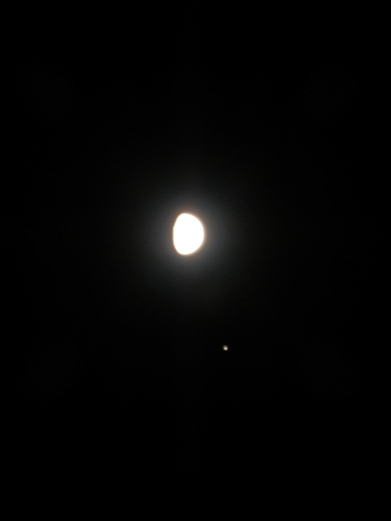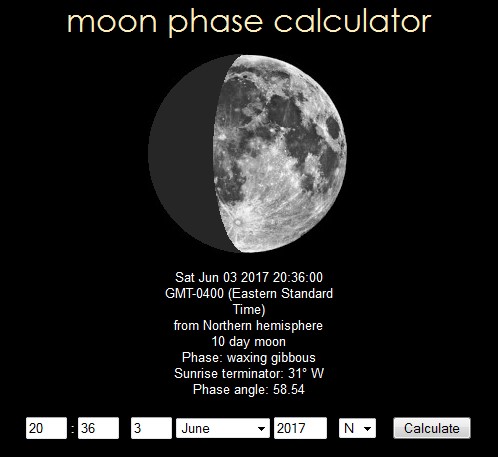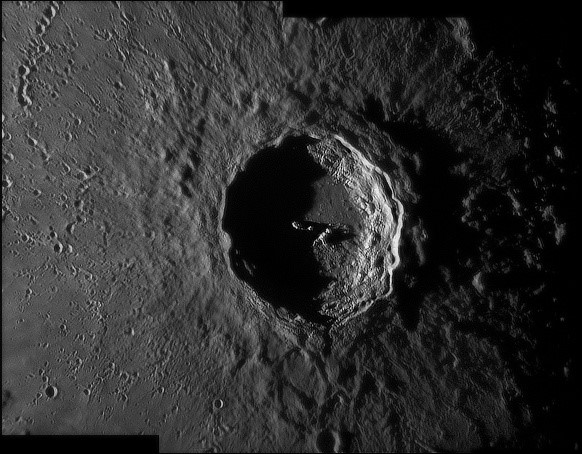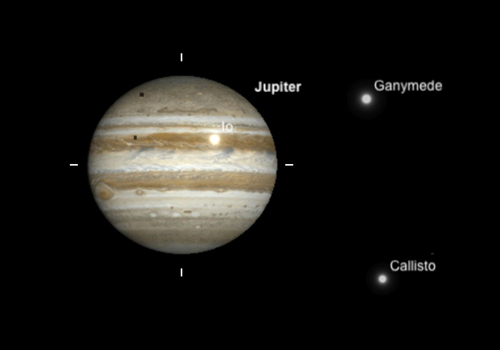Observing Jupiter/Moon Close Conjunction
by Ray Kaville
June 3, 2017 21:00 – 24:00
Location: Driveway in Hamden CT
Temperature: Approx. 64° and dry
Skies clear and a slight breeze. With a jacket it was pretty comfortable even after sunset.
Gear: Celestron 6” doublet refractor on an Orion Atlas EQ mount; 15×70 Bear binos
Eyepieces: My trusty old Meade 32mm super plossl. 7mm UO Ortho which was used on both the moon and Jupiter. Three others from Russell Optics in Arizona. A 2” 50mm, 15mm SWA & 18mm SWA. Happily, all performed very well, but I’m feeling the need for a 10mm and a 5mm.
 Cheap digital camera image of the conjunction as we saw it.
Cheap digital camera image of the conjunction as we saw it.
After a long and unproductive day I decided to have a freezer pizza for dinner. Can’t say I was lazy, but I was certainly unproductive. I hate freezer pizzas, but at 8pm when you haven’t eaten all day it was pretty good. (didn’t regret it till the next morning) About 8:30pm I decided I had to get the mail and drag the cans in off the curb when I glanced up and spotted a beautiful conjunction between Luna and Jupiter right in front of me. Who knew right? So I tossed a text to our club Prez and let him know about it. Greg was good enough to push me a picture of what Jupiter was doing at that exact moment which helped tremendously (below). Pretty spectacular and very unexpected, but it was a perfect day and they both sat above the tree line. I’d been astronomically constipated for awhile and realized I had to get some gear out.
So we set up the 15×70 binocs and took a nice view of the pair in my field of view. I was immediately able to detect darkening around the equator and two Jovian moons. Lunar phase was 10 day waxing gibbous with a terminator just west of Copernicus. Very pretty, but I wanted more. So I scoped out a spot in the driveway. The students next door weren’t home, but the inconsiderate neighbor out front was. Thankfully the leaves masked her eternal spotlight now as well as my activities. Yes, they’re very nosy and send their baying hounds out whenever they see me out there.

 Copernicus. From http://www.damianpeach.com/lunar09.htm and very similar to what I saw.
Copernicus. From http://www.damianpeach.com/lunar09.htm and very similar to what I saw.
It was disappointing to find that my widest (new) 2” 50mm plossl ep was not able to get a full view of the pair. I could arrange it for about half Luna and get most of Jupiter with the moons, but only at the extreme edges of the ep. Regardless, the conditions were exceptional compared to most I can recall and after scoping out Jupiter with some low power eps I opted to spend time on Luna. Naturally I had no idea where I was or what I was looking at, but the most amazing crater on the moon was where I stopped. It turned out to be Copernicus. Under low power I was seeing dozens or hundreds of tiny craters and debris all around the opposite sides. The terminator was loaded with detail to explore, and the stepped walls of Copernicus was a feast of detail. The inner wall was just awash with sunlight and the terracing was crystal clear. A peak was visible in the floor area and another tip was just showing itself. You could actually watch details appear and change as the sun’s rays crept down the inner eastern wall.
As I got my bearings I spotted Eratosthenes and the Appenines. All pretty bright and slightly washed out, but very detailed. I jumped up the power from 38 to 80 and things really popped. The inner wall terracing on Copernicus was distinct and the tops of the two biggest inner peaks were very clear. Light was washing almost to the floor of the crater now and as I watched it crept ever further. The terracing was multiple (I think about 5 to my count) levels and very erratic in shapes. It was pretty thrilling to see this along with the hundreds of tiny craters outside the main crater itself. On the other side of the crater were piles of rock and rough terrain referred to as the ‘“domes” near Milichius’ in Hatfields atlas. The shadowing was powerful. As I explored. the terminator progressed until the floor was about a third illuminated and the second peak was now clearly visible.
Plato was a tempting target and kept nagging at me, so at this point and I slipped a 7mm UO Ortho in bringing the mag up to about 170. This livened things up a lot. The Mare Plato displays a beautiful landscape with a perfectly flat and smooth floor with a very irregular wall and rough contrasting terrain surrounding it. It is believed this is the result of a large impact which liquefied the area inside the walls, but no internal peaks are visible so it’s possible it was volcanic activity. With the extra power and the clear viewing I was experiencing it was stunning. The collapsed wall was easily visible as were several of the larger small craters.

The Montes Alpes were easily visible along with a rille and the Mares Imbrium and Frigoris. Back at Copernicus the floor was close to half way illuminated, the terraced eastern wall was fully illuminated and detailed, and a third smaller peak was now visible. Eratosthenes was showing its twin peaks. Before it got too late I decided to spend more time on Jupiter with the stronger magnification. Its lowering altitude was pushing into the atmospheric soup, but I was able to easily make out the main storm bands with details and several bands nearer the poles. The two visible moons were Ganymede and Callisto, distinctly different in size, and as I watched I noticed a dark spot entering the planet on the side nearest Ganymede. I asked Greg if he knew of any transits at that time, and he sent me a nice image of exactly what I was seeing. Isn’t technology wonderful. The shadows turned out to be from Ganymede and Io. Io was not immediately apparent, but as I looked I noticed a bright white spot on the upper storm band. That was Io, hiding in plain sight.
We were passing 11pm and Jupiter was merging into the treetops, so time to close down. We got to watch the double shadows and Io transit across half the planet (a Trifecta!), and we got to see some pretty spectacular views on the moon. All this and a very comfortable night. Timing was perfect and so were the skies. Time to get some rest.
